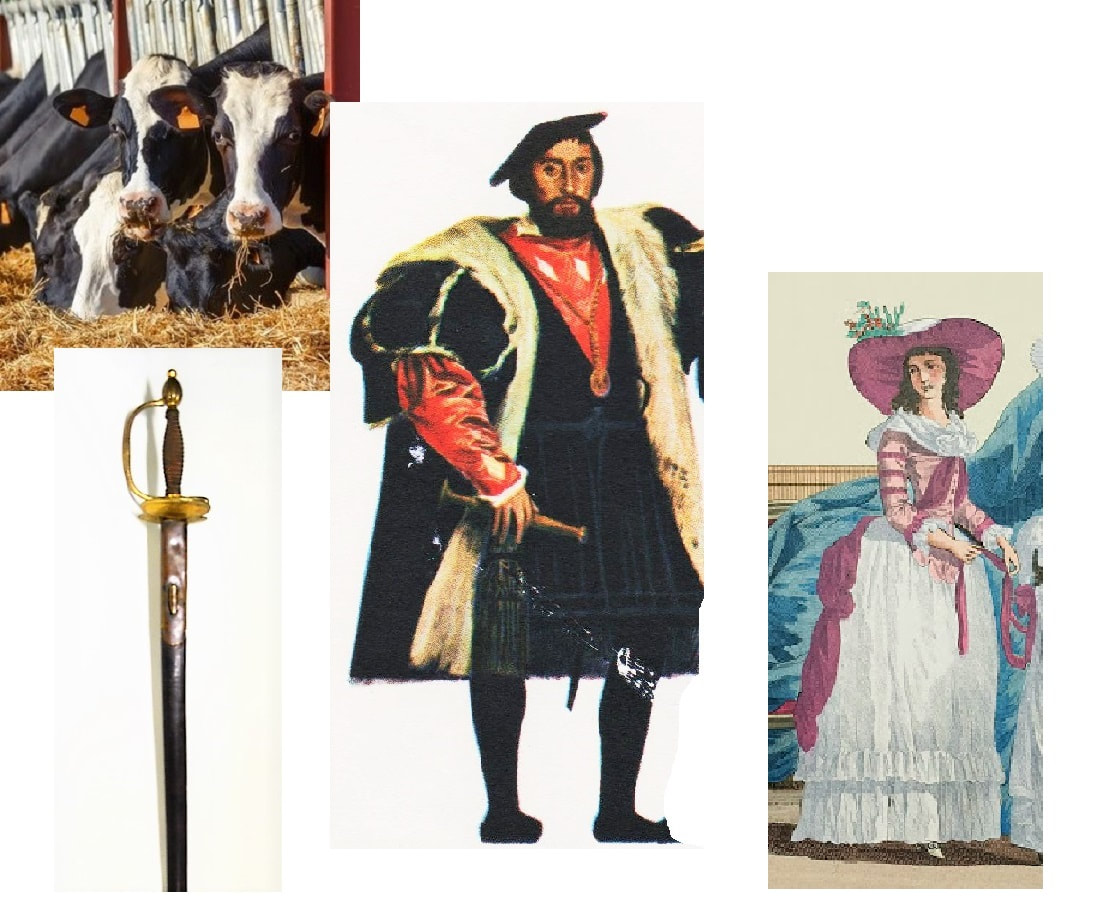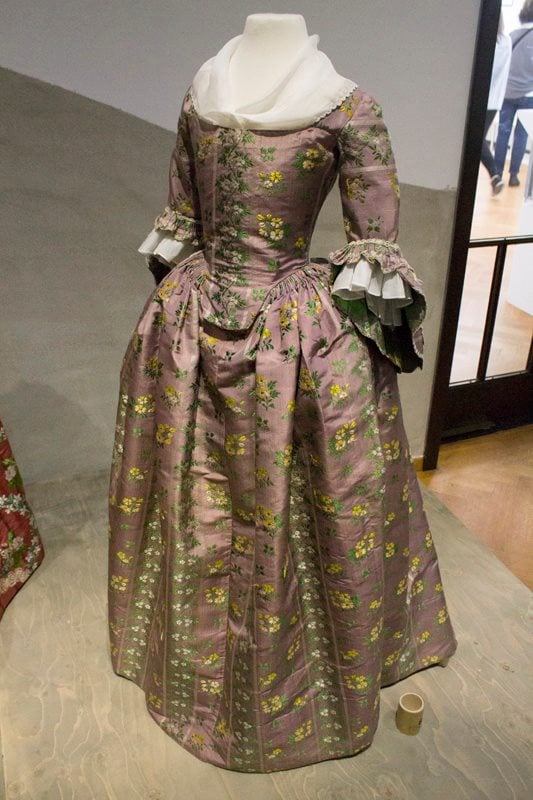The following is a brief synopsis of my research paper, without illustrations. The full paper can be accessed, including supporting photos and plates, in PDF format -- click on the icon above to read or download the entire paper. The paper is the culmination of several months of study, investigation, research and writing, which I hope will add something useful to the understanding of historical costume of the period. What do well-fed cows, swords in their scabbards, fur-lined medieval gowns, hands stuffed into pockets, and nosy Parkers all have to do with certain 18th century garment names? No idea? Please read on! At the risk of adding more verbiage to the discussion on the obscure subject of the 18th century word ‘fourreau’, I’m piling on my own thoughts – but from a completely new perspective, and to an extent not dealt with previously. I hope my research will help to illuminate this small corner of 18th century costume history. As a trained linguist and historian, and former professional translator (French/English), I had noticed some misunderstandings in publications and online discussions around the 18th century fashion term ‘fourreau’. I felt it might be useful to study the question in depth from the standpoint of linguistics, and to look at the entire history of the word in the context of costume history. Linguistics can be an illuminating resource in comprehending otherwise puzzling fashion nomenclature of earlier centuries in general, but in this case I believed it was an essential tool in untangling the confusion around the 18th century use of the intriguing fashion term ‘fourreau’. Considered along with careful scrutiny of contemporary 18th century fashion illustrations and texts, I felt linguistics could make the whole subject less mysterious. In my paper I survey the linguistic history of the French word ‘fourreau’ and how it relates to understanding fashion idioms in four centuries. In particular, I focus on the word ‘fourreau’ as used in the last half of the 18th century to refer to certain garments, tracing the word’s etymology from sources recognized by historical linguistics. At the same time, I try to provide accurate translations of 18th century French texts which accompanied relevant fashion plates in order to correct or clarify previous misinterpretations of those texts, some of which apparently stemmed from digital translations. As anyone who has worked as a professional translator knows, machines (i.e. digital translation programmes) do a poor job of understanding context, and an even worse job of understanding historical context or archaic language. Inevitably, wrong connections and assumptions occur which can colour (sometimes in very odd ways) the way English speakers will comprehend the translated text. In turn, such errors can become perpetuated, especially through online sharing. To properly translate 18th century texts requires not only an understanding of the idiomatic French of over 200 years ago, but also a knowledge of the particular setting of social history and fashion parlance. I hope that if nothing else, my paper will at least provide English translations that are as accurate as possible and faithful to the original French. Ultimately my goal is to translate larger portions of this body of 18th century fashion texts and make them available in the future to the costume history community. In the full version of my essay, you’ll find a chart outlining the linguistic history of the various forms which evolved from the very old Germanic word fôdr as a foundational word. I have not delved into the findings of linguists in this respect to confirm them, but have accepted most as presented, trusting that the world’s language experts have done the required research work and that they had good reasons to present the conclusions they did. In other words, most of their statements and conclusions make sense from the point of view of historical linguistics. I do have one significant disagreement, which forms part of the basis for my subsequent explanations. What flows from this chart are two streams of different but related meanings which, over the course of hundreds of years, branched out into a variety of uses. Three of these uses in 18th century fashion are explained in detail in the full version of my article, with support of 18th century source texts and drawings. These 18th century fashion usages all came under the umbrella of the one word ‘fourreau’. However, I demonstrate how in the fashionable mind of the era the meanings of this word were sometimes mingled. I also try to clarify some misunderstandings around the 18th century use of the word ‘fourreau’, some of which misconceptions have arisen from errors in translations of the 18th century texts. This especially applies to the term ‘en fourreau’, whose 18th century use I discuss in detail (including a number of variants), together with supporting contemporary fashion plates. Throughout the paper, I focus on the linguistic and grammatical aspects of the word ‘fourreau’ in its multi-faceted use in 18th century costume. It turns out that the 18th century use of this problematic word ‘fourreau’ is really not so mysterious after all, but follows an understandable, if somewhat whimsical and free-association use of language in the fashion milieu of the time. In addition, I show how this enigmatic, mutable and peripatetic word ‘fourreau’ was not confined to the 18th century, but wandered through time to turn up here and there in various guises. I outline its use in these later fashion contexts partly to shed light on how it may have been understood in its earlier, 18th century usage. I consider the problem of attempting, from the perspective of the 21st century, to enter into the linguistic, social, cultural, and historical milieu of late 18th century France, signalling ways in which fashion historians need to be cautious about applying modern prejudices and expectations when looking at such fashions. Lastly, I summarize my findings and conclusions based on my research, and propose some alternatives to correct – or at least avoid perpetuating – one apparently inadvertent faux pas in particular which has become accepted by many as a convention in the language of costume historians: the infamous ‘en fourreau’. I hope you will be able to find time to read through the complete essay on this esoteric topic of fashion history. Although it is a very long text because I’ve tried to deal with the subject as fully as possible, fashion plates and other images do make up a large part of it. I don’t claim to have exhaustively dealt with the subject in this paper, but hopefully my findings and conclusions will open up new areas of discussion. I’d be pleased to hear your comments or questions on this essay, and would be delighted if you have additional historical sources to share which could shed further light on this admittedly arcane subject. Postscript - September 20, 2019:
Photographs of an extremely rare back-lacing, silk-linen girl's "fourreau" (frock-dress) of about 1770-75 in incredibly beautiful condition have come to my attention. The photographs are stated to be from the Gemeentemuseum of The Hague, Netherlands. I'll be incorporating these into a second edition of my paper, but for the time being they are included here for interest. This dress is an earlier style than most of those in 18th Century illustrations, but nonetheless shows the typical construction details of young girls' dresses of the era.
8 Comments
21/10/2019 11:30:57 am
Hello everyone, I found this pretty shawl and it’s got a sale right now, so I’m looking at getting this as a gift. Need help though! I want to know what you think best colour would be, any suggestions?
Reply
29/1/2020 02:24:43 am
This is this kind of an excellent resource that you are providing and you give it away for free of charge. I adore seeing web sites that understand the value of providing a quality resource for free of charge. It?s the old what goes close to arrives close to routine. Did you acquired plenty of links and I see lots of trackbacks?
Reply
The Fashion Archaeologist
1/2/2020 03:57:28 pm
Thank you, I'm glad it was helpful and interesting! My research is free to all, as a service to the costume history community.
Reply
Susan K Wooden
29/3/2021 12:19:02 pm
I've tried several times to access the pdf of your "en fourreau" research, in different browsers, but for some reason the link is not working for me. I would greatly appreciate your emailing the document to me, or letting me know if or when you can get the link to work. Thank you very much!
Reply
4/1/2022 05:53:47 am
Great post! We adore this blog and This information is very good.Luminous T-Shirt Printing best T-shirt printing service provider.
Reply
8/1/2022 10:33:45 am
Leather jackets have universal use. Men, women, and kids prefer it. Why are leather jackets popular? Leather jackets are popular due to the following reasons.
Reply
17/3/2023 04:24:47 am
Generally, I don’t read articles on blogs, but I wish to say that this write-up forced me to check out and do so! Your writing style has amazed me. Thanks, very nice article.
Reply
28/9/2023 07:45:08 am
This is a very Awesome and Help full Article. It really helps me. Thanks for sharing this.
Reply
Leave a Reply. |
AuthorPatricia Preston, a.k.a. The Fashion Archaeologist, Historian, linguist, pattern-maker, enthralled by historical fashion, especially the 18th, 19th and 20th centuries.. Archives
August 2022
Categories
All
|
||||||||








 RSS Feed
RSS Feed